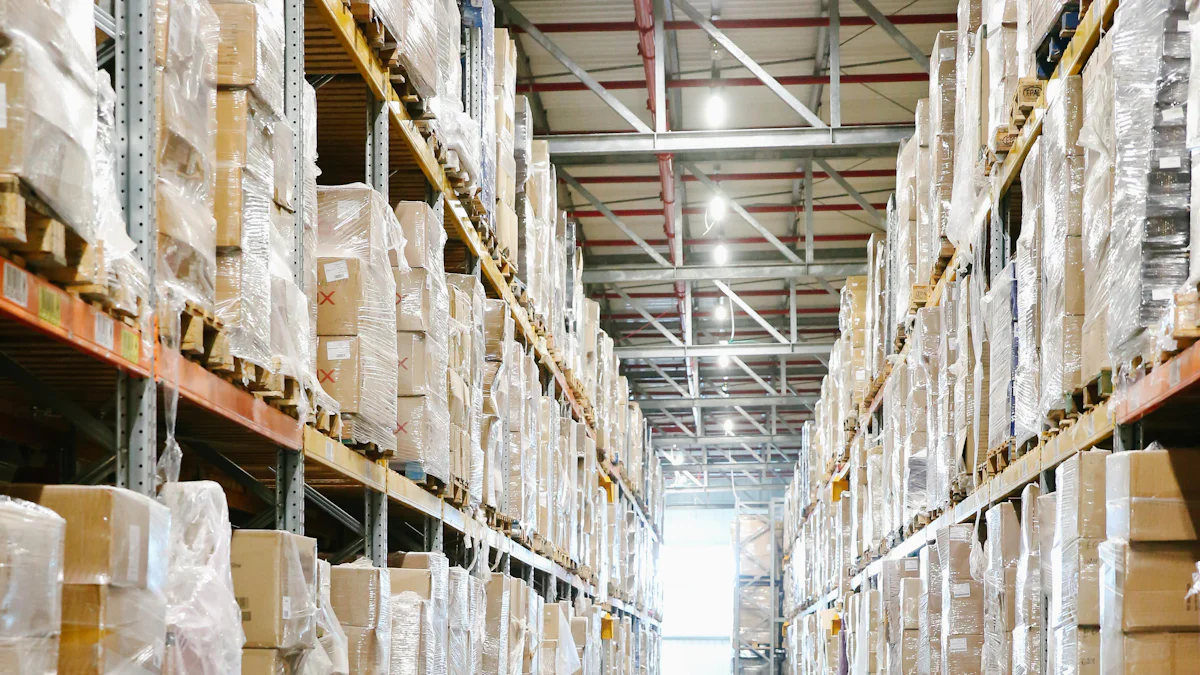Top Methods to Improve and Streamline Manufacturing Supply Chains-duplicate

An optimized manufacturing supply chain plays a vital role in achieving cost efficiency and meeting customer expectations. It reduces supply chain costs by up to 15%, enhancing overall performance and fostering customer loyalty. Companies can improve service quality through timely deliveries, maintain inventory flow to prevent stockouts, and utilize advanced technology for better visibility. These improvements ensure businesses remain competitive in a fast-paced market.
JUSDA exemplifies how innovation transforms supply chains. By integrating intelligent solutions, it empowers manufacturers to streamline operations and improve efficiency, ensuring consistent delivery of high-quality products.
Leveraging Technology for Manufacturing Supply Chain Optimization

Implementing JusLink for Real-Time Supply Chain Management
JusLink, JUSDA's intelligent supply chain platform, revolutionizes supply chain management by providing real-time visibility and control. It integrates advanced technologies like AI, IoT, and cloud computing to streamline the supply chain process. Businesses can monitor inventory levels, track shipments, and predict disruptions with AI-driven forecasting tools. This ensures timely adjustments to supply chain operations, reducing delays and improving supply chain efficiency.
The platform's intelligent risk management system enhances decision-making by identifying potential risks and providing actionable insights. Automated application management further streamlines the process by tracking shipment statuses and detecting anomalies. JusLink's ability to optimize supply chain operations makes it an indispensable tool for businesses aiming to streamline supply chain processes and achieve supply chain optimisation.
Using IoT to Enhance Visibility and Reduce Lead Times
The Internet of Things (IoT) has transformed the manufacturing supply chain by enabling real-time data sharing and improving visibility. IoT devices provide continuous updates on inventory, production rates, and transportation status. This enhances awareness and allows businesses to respond quickly to changes. For example, real-time insights enable companies to adapt to demand fluctuations and allocate resources efficiently.
Aspect | Explanation |
|---|---|
Real-time Data Sharing | Continuous updates on inventory levels, production rates, and transportation status enhance awareness. |
Quick Decision-making | Access to real-time data enables timely adjustments to production schedules and resource allocation. |
Demand Responsiveness | Real-time insights allow for quick adaptation to market demand fluctuations. |
Efficient Resource Allocation | Monitoring inventory and demand trends leads to optimized management and cost savings. |
By leveraging IoT, businesses can streamline the process of managing supply chain operations, reduce lead times, and improve supply chain operations.
Automating Processes to Streamline Operations
Automation solutions play a critical role in streamlining supply chain processes. They reduce human intervention, improve accuracy, and enhance operational efficiency. Common challenges like manual processes, inefficient inventory management, and transportation issues can be addressed through automation. For instance, predictive analytics powered by AI helps forecast disruptions and optimize inventory levels. Mobile inventory solutions enable real-time tracking, ensuring data accuracy and better decision-making.
JUSDA incorporates automation into its supply chain management solutions to improve supply chain operations. By automating repetitive tasks, businesses can focus on strategic activities, leading to significant improvement in overall efficiency. Automation not only streamlines operations but also ensures an effective supply chain capable of adapting to market changes.
Optimizing Inventory Management for Improved Efficiency
Adopting Just-in-Time (JIT) Practices
Just-in-Time (JIT) practices revolutionize inventory management by aligning production schedules with demand. This approach minimizes excess inventory and reduces holding costs. Businesses adopting JIT practices experience significant benefits, including waste reduction, improved efficiency, and enhanced productivity. By eliminating overordering, companies optimize cash flow and streamline the supply chain process.
JIT inventory allows businesses to reduce inventory holding costs, optimize cash flow, and promote better inventory management practices by increasing visibility and control over stock levels.
JIT also enhances supply chain efficiency by automating processes and shortening production cycles. Companies can deliver products on time while maintaining high-quality standards. This method eliminates bottlenecks, reduces delays, and ensures smooth supply chain operations.
Utilizing Advanced Inventory Management Tools
Advanced inventory management tools provide businesses with the ability to monitor and manage inventory levels effectively. These tools leverage real-time data and analytics to address inventory challenges. Features like demand prediction and automated replenishment improve supply chain process optimisation by ensuring accurate forecasting and timely restocking.
Feature | Description |
|---|---|
Demand Prediction | Uses machine learning and big data analytics to forecast demand trends. |
Safety Stock Calculation | Adjusts safety stock levels in real time to prevent stockouts or surpluses. |
Automated Replenishment | Automates restocking based on demand forecasts, reducing manual errors. |
Scenario Planning | Helps create contingency plans for operational disruptions. |
Supply Network Visibility | Tracks supply levels and supplier performance for efficient management. |
JUSDA integrates these tools into its solutions, enabling businesses to improve supply chain operations. By adopting such technologies, companies achieve better inventory control and enhance overall efficiency.
Establishing Clear Communication Protocols for Consistency
Clear communication protocols are crucial for maintaining consistency in supply chain operations. Best practices include:
Developing standard operating procedures (SOPs) and guidelines for communication.
Providing regular updates on delivery times, inventory levels, and production schedules.
Encouraging feedback from suppliers, carriers, and stakeholders to identify areas for improvement.
Establishing contingency plans for unexpected events and ensuring all parties are aware of these plans.
JUSDA advocates for the use of centralized communication hubs and real-time updates to enhance supply chain process optimisation. By implementing these protocols, businesses can improve supply chain effectiveness and respond proactively to disruptions.
Utilizing Data Analytics and Forecasting to Improve Supply Chain Management
Analyzing Historical Data for Better Decision-Making
Analyzing historical data provides businesses with valuable insights to enhance decision-making in the manufacturing supply chain. By combining historical data with real-time trends, companies can predict customer demand and identify potential disruptions. This proactive approach allows organizations to adjust their supply chain process to meet demand and address challenges effectively.
Historical data analysis offers several benefits:
Aspect | Benefit of Historical Data Analysis |
|---|---|
Demand Forecasting | Improves accuracy in predicting future product demand. |
Operational Efficiency | Identifies areas for process optimization. |
Risk Management | Helps in anticipating potential disruptions. |
Supplier Performance | Evaluates and enhances supplier reliability. |
JUSDA leverages advanced analytics to help businesses optimize their supply chain operations. By utilizing historical data, companies can improve supply chain effectiveness and achieve cost efficiency.
Implementing Predictive Analytics for Demand Forecasting
Predictive analytics transforms demand forecasting by enabling manufacturers to anticipate future trends. This technology uses data-driven insights to optimize the supply chain process and ensure products are available when needed. Accurate demand predictions reduce stockouts, improve customer satisfaction, and enhance supply chain efficiency.
Advantage | Description |
|---|---|
Cost Savings | Predictive maintenance can save significant money by preventing unexpected equipment breakdowns. |
Increased Customer Satisfaction | Accurate demand predictions help ensure products are available, reducing stockouts and customer frustration. |
Improved Product Quality | Early detection of quality issues through data analysis helps maintain product standards. |
Proactive Decision-Making | Enables manufacturers to address potential issues before they escalate, leading to smoother operations. |
Future Readiness | Continuous data analysis prepares manufacturers for changing market conditions and customer preferences. |
JUSDA integrates predictive analytics into its JusLink platform, empowering businesses to make proactive decisions and streamline their supply chain process.
Streamlining Logistics and Shipping with JUSDA Solutions

Optimizing Transportation Routes with JusLink
Efficient transportation routes are vital for enhancing the logistics and shipping process. JusLink, JUSDA's intelligent supply chain platform, optimizes transportation by leveraging advanced technologies like AI and IoT. The platform analyzes real-time data to identify the most efficient routes, reducing transit times and fuel consumption. This optimization minimizes delays and ensures timely deliveries, which improves supply chain effectiveness.
JusLink also provides real-time tracking of shipments, enabling businesses to monitor their logistics operations closely. By identifying potential disruptions early, companies can make proactive adjustments to maintain smooth supply chain operations. JusLink's ability to streamline the transportation process makes it an essential tool for achieving supply chain optimisation.
Partnering with Reliable Logistics Providers
Reliable logistics providers play a crucial role in improving supply chain efficiency. Partnering with these providers offers several benefits:
Reducing costs associated with logistics operations.
Enhancing customer satisfaction through dependable service.
Additionally, reliable providers offer expansive networks that ensure timely deliveries. They help businesses save costs by leveraging advanced technologies, eliminating the need for upfront investments. Offloading logistics tasks to these providers also reduces labor costs and allows companies to focus on core activities. JUSDA collaborates with trusted logistics providers to deliver seamless logistics and shipping processes, ensuring businesses achieve supply chain optimisation.
Implementing Warehouse Management Systems (WMS)
Warehouse Management Systems (WMS) contribute significantly to streamlined logistics in manufacturing. These systems optimize the control and administration of warehouse operations, enhancing inventory visibility and synchronizing material movements. WMS automates key processes such as inventory receiving, picking, packing, and shipping, reducing manual errors and improving efficiency.
JUSDA integrates WMS into its solutions to provide real-time visibility and control over inventory. This integration reduces costs, improves service quality, and ensures compliance with industry standards. By adopting WMS, businesses can enhance collaboration across the supply chain process and achieve better operational outcomes.
Embracing Sustainability and Continuous Improvement in Supply Chain Management
Reducing Waste Through Lean Manufacturing Principles
Lean manufacturing principles help businesses reduce waste and improve supply chain efficiency. These principles focus on aligning processes with customer needs and eliminating non-value-adding activities. Companies can follow these steps to implement lean practices:
Distinguish value-creating steps from wasteful activities.
Create a smooth flow in the process.
Pull production based on customer demand.
Strive for continuous improvement.
Value stream mapping plays a critical role in this approach. It helps businesses identify steps that reinforce customer value and eliminate inefficiencies. By adopting lean manufacturing, companies can streamline their supply chain process, reduce costs, and enhance overall operations.
Once businesses understand what customers value, they can map their processes to identify and eliminate wasteful activities, ensuring a more efficient supply chain process.
Investing in Sustainable Practices and Green Suppliers
Sustainability in the manufacturing supply chain is essential for long-term success. Businesses can adopt several sustainable practices to reduce their environmental impact:
Establish supplier codes of conduct that include labor protections and environmental standards.
Conduct life cycle assessments to evaluate the environmental impact of products.
Utilize IoT monitoring for real-time compliance with sustainability standards.
Implement sustainable transportation methods to lower greenhouse gas emissions.
Leading companies also invest in renewable energy sources and partner with green suppliers. For example, using recycled materials and optimizing transportation routes can significantly reduce emissions. JUSDA supports these efforts by integrating sustainable practices into its supply chain solutions, helping businesses achieve supply chain optimisation while reducing their carbon footprint.
Encouraging a Culture of Continuous Improvement
A culture of continuous improvement fosters innovation and enhances supply chain operations. This approach encourages employees to identify inefficiencies and suggest improvements. It also aligns supply chain activities with customer demands, improving responsiveness and satisfaction.
Key benefits of continuous improvement include:
Lowered procurement, inventory, and transportation expenses.
Enhanced customer loyalty through better service delivery.
JUSDA emphasizes continuous improvement by integrating advanced technologies into its solutions. This empowers businesses to optimize their supply chain process and maintain a competitive edge. By fostering a mindset of ongoing enhancement, companies can adapt to market changes and achieve long-term success.
Streamlining the manufacturing supply chain involves adopting strategies that enhance cost efficiency, improve customer satisfaction, and enable faster time-to-market. Key methods include leveraging advanced technologies, optimizing inventory management, and fostering collaboration across the supply chain. These approaches ensure better agility, flexibility, and inventory control, helping businesses adapt to market changes effectively.
JUSDA, through its JusLink platform, exemplifies innovation in supply chain management. By integrating IoT, cloud computing, and big data analytics, JusLink enhances efficiency and productivity across industries like electronics and automotive. Its tailored solutions optimize resource allocation, demonstrating its pivotal role in supply chain optimisation.
Adopting these strategies empowers businesses to improve efficiency, remain competitive, and meet evolving market demands. Companies can achieve sustainable growth by embracing these methods and leveraging tools like JusLink.
See Also
Enhancing Supply Chain Strategies for Advanced Manufacturing Challenges
Essential Techniques for Effective Supply Chain Optimization Success
Five Cutting-Edge Strategies for Supply Chain Optimization Uncovered
Maximizing Efficiency in Your Automotive Supply Chain Operations
